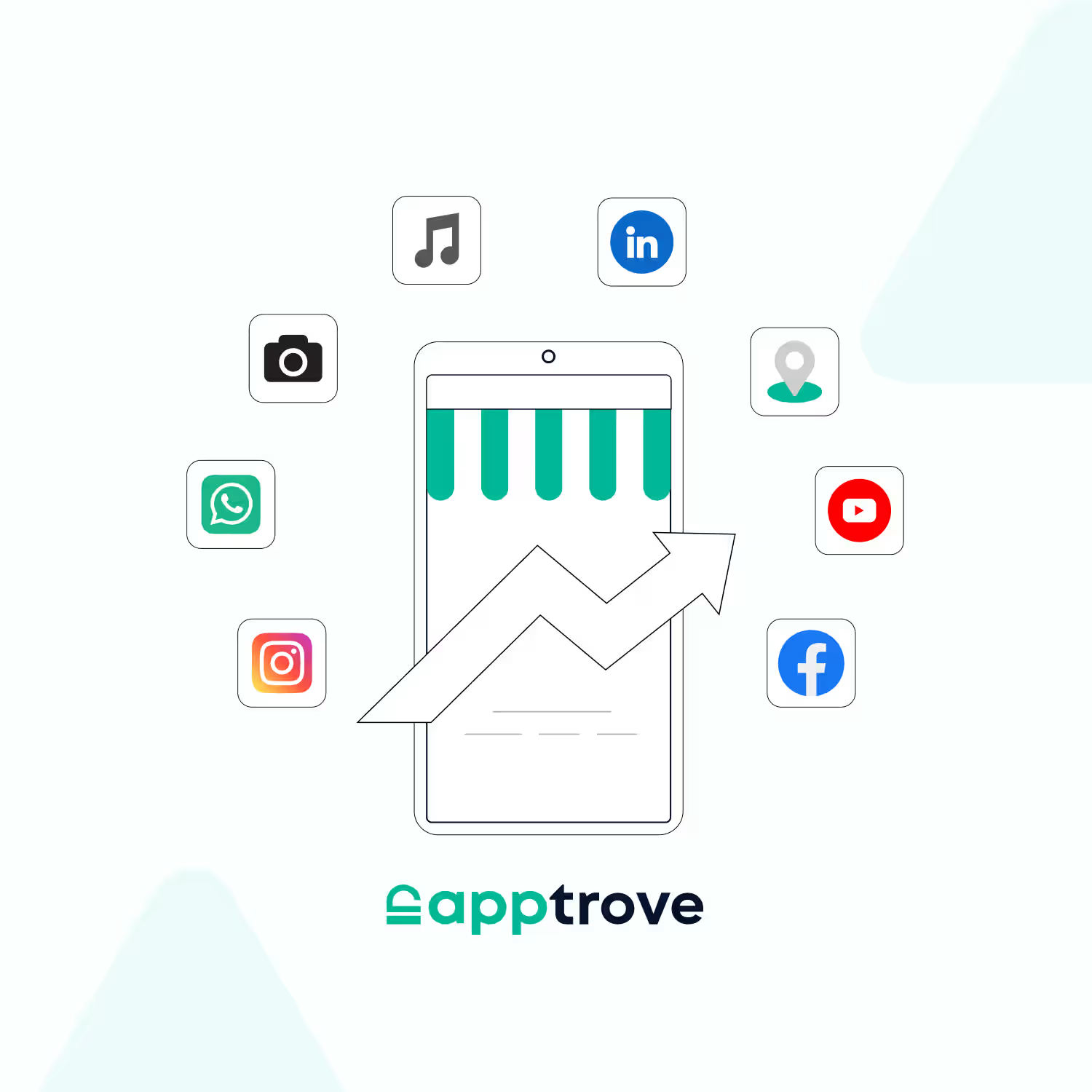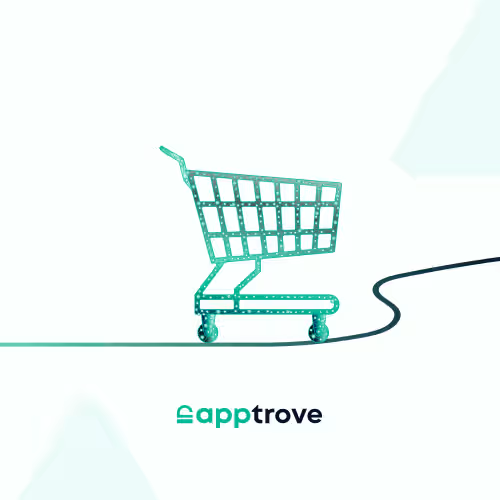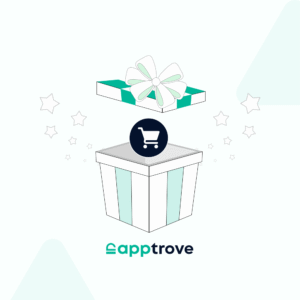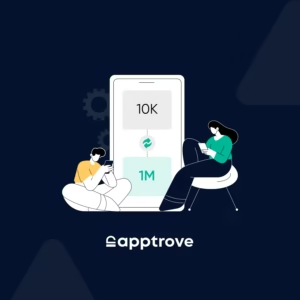Introduction
In a increasingly digitalised world, we are noticing that as attention spans shrink and competition proliferates, App Store Optimization (ASO) has transitioned from a nice-to-have marketing strategy to a must-have critical component of mobile success. As we enter 2025, the app marketplace has reached unprecedented saturation with millions of apps competing for discoverability on the Apple App Store and the Google Play Store. Whether you are an indie developer or an established enterprise, organic discovery of your app has turned out to be one of the largest hurdles within the mobile ecosystem.
With over 5 million apps across both stores, building an app is no longer the hard part; getting it discovered and downloaded now is. That is where ASO comes in. In simple terms, App Store Optimization is the process of optimizing your app to achieve higher visibility in app stores and drive organic downloads. It is the app world’s equivalent of SEO, which is dedicated not only to achieving high search rankings, but also CTR, conversions, and retention.
ASO combines several approaches, including keyword optimization, creative asset design, ratings and reviews, localization, and insights. These elements work together to improve your app’s positioning, help it appear in relevant search results, and convince visitors to the store to become users.
In this article, we will be sharing everything you need to know about ASO in 2025 —the basic concepts, algorithm changes, advanced tools, approaches, and trends. You will learn how to optimize your app title, description, and assets, how to conduct keyword and competition research, and how to interpret analytics and A/B test results to continually perfect your approach. Whether this is your first app launch, or you are expanding an existing one, you will have a full play book to achieve success in the app store.
What is App Store Optimization?
User engagement with mobile apps dominating the digital age, made App Store Optimization (ASO) a necessary strategy for the success of the app. ASO involves the steps taken to increase the visibility and app ranking in app stores such as the Apple App Store and Google Play Store. Sometimes referred to as ASO App Store Optimization, the process is aimed at generating organic downloads and keeping user engagement high through making apps more visible.
Similar to SEO used by websites to get higher ranks on search engines, the app employs the optimization of ASO to get higher ranks in app store searches. However, SEO gives importance to backlinks and domain authority while ASO only revolves on specific parts like app title, description, keywords, screenshots, and user reviews.
An efficient App Store Optimization tool is capable of showing the user the most suitable keywords like “aso app” or “aso SEO” that can make the user easily find and download the app. The more your app is well-positioned according to the relevant keywords, the greater the likelihood that people will find it and download it.
ASO App Store Optimization Defined
ASO, or App Store Optimization, is the SEO of the app ecosystem. Just as SEO takes website content and optimizes it for Google and other search engines, ASO allows developers to optimize their app for app stores. This means optimising your app’s metadata (title, description, and keywords), visuals (icons, screenshots, and videos), and reviews to increase discoverability.
The process looks a little different between the two platforms:
- On the Apple App Store, your app title, keywords fields and subtitle take precedence.
- On the Google Play Store, the algorithm is more driven by the app description and user metrics (such as downloads and retention).
Understanding the differences between these two platforms is key to developing a successful strategy.
Why ASO is Important in 2025?
The volume of mobile app usage has continued to grow in 2025. Recent estimates forecast that there could be over 200 billion global app downloads each year, with consumers spending more than $150 billion on apps and in-app purchases.
With millions of apps now widely available for consumers, App Store Optimization is more critical than ever. Proper ASO will allow you to do the following:
- Improve the visibility of your app in AWS and crowded marketplaces.
- Improve your organic downloads by being more in-tune with the search behaviours of users.
- Improve engagement by making sure that right from the beginning your app is appealing to the right audience.
It doesn’t matter if you are using a specified ASO, App Store Optimization tool or even optimizing keywords such as “aso app” and “aso SEO,” it is vital to invest in ASO and expected to be a primary driver of growth ahead of the competitive app economy in 2025.

How ASO Works: Core Elements of ASO Optimization
App Store Optimization (ASO), is not merely to simply add some keywords, it is a holistic way of optimizing many components relating to your app listing. Titles, and the keyword field, are examples of components in your app listing that help make your app more searchable or discoverable in both app stores.
We will go through the core pillars of ASO implementation that will help your app rank better, increase downloads, and reach the users that need to discover your app the best.
Title & Subtitle Optimization
The app title and subtitle are very possibly the two most important piece of real estate you have in App Store Optimization. Apple and Google’s algorithm will weight these areas very heavily.
- Utilize your keywords: If possible, you should have your primary keyword in your title. An example would be “BoostIt – App Store Optimization Tool”. Based on the keywords, the title “BoostIt – ASO Tool” would be less relevant.
- Stay within character limit: The Apple App Store has 30 characters for the title and 30 for the subtitle. You should make every character count, and consider how much of your title can be keywords or how you can juggle the title with branding.
- Don’t repeat words: Do not put a word in the subtitle that is already in the title. Use the subtitle to put in secondary keywords like “ASO App Store optimization” or “aso optimization” where you can cast a wider net with your keywords.
App Description Optimization
Your app description can serve as not only a selling tool, but also a place to incorporate keywords naturally – especially for Google Play, where the description is indexed for search.
- Keyword placement: Primary keywords (for example, “App Store Optimization” and “aso app”) should be placed towards the beginning of the description. Secondary keywords (like “aso seo” and “App Store Optimization Tool”) can be dispersed throughout the body in a natural flow.
- Compelling content: The first few lines should communicate the features, benefits, and use cases of the app. You are going to want to address convenience and/or pain points users may encounter and how your app solves them.
- Call to action: Tell users to download, try, or learn more–increasing both conversion and user engagement.
Keyword Field Strategy
- Smart keyword research: Use an ASO tool to find the highest volume and lowest competition keywords. Focus on relevancy first–“aso app” and “App Store Optimization Tool” should be applicable for what users are actually searching.
- Avoid keyword stuffing: Stuffing too many keywords into the keyword field can severely hinder performance–consider commas to separate keywords and omit stop words (aka, “the” or “and”).
- Keep it unique: Don’t repeat the same keywords you put in the title or subtitle. This means you can use alternative keywords such as “aso seo” or more specific terms related to the app that your competitors might not be using.
Visual ASO: Impact of Icons, Screenshots & Videos
While metadata forms the backbone of your App Store Optimization process, visuals present the user’s first view of your app. The best visuals will not only turn heads but will dramatically impact install rates. When we discuss Visual ASO, we’re focusing on the app icons, app screenshots and app promo videos you can optimize to boost attention and drive user action. A good visual strategy will form an essential part of any ASO App Store Optimization plan.
App Icons That Convert
Your app icon will usually be the first item that a user will see, and it is vital to your click-through and conversion rates.
- Design Principles: You want your icon to be simple, recognizable, and related to the function of your app. Aim for bold color choices, and minimal text, and shapes that are engaging and easy to distinguish. You will want an icon design that does not appear cluttered; remember your icon is usually quite small on a screen.
- Branding meets economy of function: You want your icon to represent your brand, and to display your app’s value with one glance. When combined with good ASO optimization, an engaging app icon can directly help improve your rank and downloads.
- Examples of successful icons: The top apps in any category (productivity, fitness, etc.) generally use bold, clean and emotionally engaging icons. You can look to the high-performing icons as part of a bigger plan of visual representation for your App Store Optimization work.
Screenshots and Promo Videos
Once users tap on your app listing, screenshots and videos are the next decision-making tool. They share your app’s story without writing a word.
- Visual storytelling: the screenshots should walk users through the most valuable features of your app. It can show real use cases, benefits, and a fluid user interface. You can use captions to emphasize points, and if it occurs naturally, include terms like “aso app” or ”App Store Optimization Tool”.
- Promo videos: short entertaining, and engaging videos can improve conversion by 23%. Your promo videos should highlight real users in the app, core functionality, and your unique selling points.
- A/B testing visuals for engagement – Use ASO tools to test the different designs for your app icon, screenshots order, and video thumbnail. Testing with actual data will show what visual elements resonate with your audience, therefore boosting downloads and retention.
User Ratings & Reviews: The Social Proof Factor
In the cutthroat world of mobile development, user ratings and reviews are one of the most powerful components of App Store Optimization (ASO). This social proof not only builds trust among potential users, but it is also a direct contributor to your app store search visibility and ranking.
An app with a good rating is much more likely to be discovered, downloaded, and recommended—making reviews one of the most compelling components of any ASO app strategy.
Importance of Ratings in ASO SEO
Good ratings help your app discoverability in more ways than one.
Ranking impact: App store algorithms assign a high level of importance to user ratings when evaluating where your app appears in search results. In the Apple App Store, Google Play, or anywhere else, receiving consistent ratings of 4+ stars will improve your chances of ranking for high-value keywords like “App Store Optimization” or “aso SEO.”
Trust and conversions: Users are far less likely to download an app that has no strong user ratings or positive reviews. Not only does an app with good ratings improve your conversion rate, but they also send positive signals to the app store algorithms.
Improving your app rating:
- Resolve bugs quickly and engage with feature requests.
- Improve your app’s UX/UI to remove friction and increase satisfaction.
- Use in app prompts wisely to request feedback after good experiences.
- Utilize an App Store Optimization Tool to monitor trends and observe the effect on your ratings of updates.
Generating & Managing Reviews
Consistently generating and managing reviews is a tactic you will use as part of your broader ASO optimization strategy. Keep this in mind:
Effectively prompting users – the best times to ask for reviews is when they are highly satisfied, such as when a user accomplishes something or completes a task. Timing is fundamental to ensure you are getting feedback from happy customers.
Automate prompts to request reviews – make use of ASO tools or SDK options to automate how you request reviews and when without disrupting the user experience or interaction with your app.
Responding to poor feedback – Always be polite and professional with any feedback. Public replies will show users you care.
Identify repeat issues, fix them as part of versions & updates, and ask respondents to return/service and update their reviews.
Utilize an App Store Optimization Tool to categorise repeat poor reviews to identify trends and improve your updates in the future.
In 2025, positive user ratings and active review management are important for the app success, no matter if you are launching a new aso app or optimizing an existing aso app, using smart App Store Optimization techniques, which include review management, will increase your visibility, downloads and help to build long-term trust.
Keyword Research for ASO: Finding What Works
Effective App Store Optimization (ASO) starts with effective keyword research. Choosing the best keywords will give your app more relevancy in searches, increased visibility, and more downloads. Whether you are releasing a new ASO app or optimizing an existing one, keyword strategy is foundational to your overall ASO success.
Knowing how to find, assess, and rank keywords has the potential to give your app serious momentum in the Apple App Store and Google Play Store alike.
WHERE TO FIND ASO KEYWORDS?
To prepare a successful strategy, you will need the best App Store Optimization tools to find high-value keywords.
Best Tools for Keyword Discovery: Tools like AppTweak, Sensor Tower, Mobile Action, and Keyword Tool have strongholds in App Store Optimization, since they track throughout the metrics of search volume, keyword difficulty, competition, and emerging keyword trends that are necessary to establish a strong ASO optimization plan.
Keyword Difficulty & Search Volume: High search volume represents more potential traffic, but that is certainly often accompanied by high competition. Building a sound strategy means considering both keyword difficulty and relevancy to your app’s features. For instance, although “App Store Optimization” might be a very competitive term, a long-tail variation like “App Store Optimization Tool for small business” will likely be easier to rank for.
Use these tools to determine not just what is trending, but what is most closely aligned with your app purpose and user intent.
How to Prioritize Using Keywords for ASO Optimization?
Once you’ve identified potential keywords, the next step is prioritization – essentially, a more robust choice of information based on user behavior and competition in the market.
Intent-based keywords versus volume-based keywords: Keywords such as “aso seo” may see many searches, but if your app is a tool targeted at beginner users, a particular phrase like “easy App Store Optimization Tool” will likely rank more users who have strong intent to download.
Long-tail keywords vs short-tail keywords: Long-tail keywords (e.g. “ASO App Store Optimization tool for productivity apps”) generally have lower competition and are more likely to draw qualified users. Short-tail keywords (e.g. “aso app”) help you to cast a wider net, but tend to be more difficult to rank for.
Strategic placement: After your prioritized keywords have been selected, be sure to include your keywords naturally in your app title, subtitle, description and keywords (Available for Apple only). Avoid stuffing your keywords – this will hurt you ability to discover and usability.
Correct keyword research, and implementation make up the foundation of any successful App Store Optimization strategy. By using the right App Store Optimization tools, and refining the focus of relevance, and reach, your aso app can receive better rankings and more engaged users.
Competitor Analysis in ASO Strategy
When it comes to App Store Optimization (ASO) in today’s crowded app stores, understanding the competitive landscape is a must. Competitor analysis can help you identify what tactics other apps are deploying to rank well, gain visibility, and attract downloads, whether you are optimizing a new aso app or looking to enhance an existing one. Learning from your competitors will be an important step to improve your ASO App Store Optimization performance.
Understanding Your ASO Competitors
Your ASO competitors are not necessarily your business competitors. Rather, they are the apps that rank for the same keywords you use in your app, whether directly or indirectly.
How do you analyze competing apps? It all starts with identifying the apps that appear for your desired keywords like “App Store Optimization”, “aso seo”, or “App Store Optimization Tool”. You can also use ASO tools like AppRadar, MobileAction, or App Annie, to look at keyword rankings for those apps as well as download estimates and visibility.
Important metrics you should track:
- Keyword overlap: take note of which keywords your competitors rank for that you are missing.
- App title and description: assess where competitors deploy ASO optimization tactics.
- Ratings and reviews: investigate what users like and dislike about their app. This way you can identify possible opportunities or pitfalls.
Knowing these metrics allows you to improve your own App Store Optimization strategy in order to compete in the same category.
Benchmarking and Improvement Strategy
Now that you have established who your competitors are, it is time to benchmark their performance metrics and derive insights to improve your app’s ASO strategy.
- Keyword learnings: Analyze the keywords your competitors are ranking for. Are they using short-tail phrases like “aso app” or long-tail keywords such as “best App Store Optimization Tool for iOS”? Use this information to improve your own set of keywords.
- Visual comparison: Assess what kind of icons and screenshots your top competitors are using. Are they using callouts? Feature callouts? Strong branding of the app? A/B test similar visuals from ASO tools to determine what appeals to your users.
- Review learnings: Look at user feedback on competitor apps. Are users asking for features that your app already offers? Call those out in your description or visuals.
- Performance insights: Benchmark their download velocity, user engagement, and keyword trends over time using an App Store Optimization Tool. Then compare these performance insights alongside your numbers to identify gaps and opportunities.
Localizing Your ASO Strategy
A global app marketplace means that simply translating your app won’t be enough. App Store Optimization (ASO) needs to be specific to different languages, cultures, and search behavior in order to drive engagement and downloads. A strong ASO App Store Optimization strategy goes beyond a general identification of keywords; it’s about localizing every aspect of your aso app experience to resonate with users within specific markets–this is where the road to global success starts.
Why does App Localization Matter?
Localization is not simply a function of language, it’s about linking to, a regions unique culture, patterns of behavior, and search intention. For ASO work to truly adapt–localization will also have to include:
- Language accuracy: These will need to be native level translations of the apps name, description, and the actual keywords used to increase clarity & trust.
- Market-specific keywords: A user in Spain might search, “editor de fotos,” while someone in the U.S. searches, “photo editor” our global App Store Optimization Tool enables us to identify these differences, and to adjust strategy characteristics accordingly.
- Cultural intended relationship: No design element, visual or colour behaves the same the world over. For example; a red icon could engage users in China, yet be intentionally avoided in Western markets.
- Case studies: Apps such as Duolingo and TikTok have achieved global appeal by collaborating with local talent to articulate local ASO SEO approach.
Tools and Techniques for Global ASO Optimization
At scale, localization can be challenging but possible if you have the right tools and automation.
- Automation of localization: Leverage ASO platforms like AppTweak, OneSky or Lokalise to help manage translations across languages, track updates to app metadata, and updates to keyword variations among many other regions. These platforms enable you to automate tracking of localization changes across app stores.
- SEO + ASO: The most app visibility can be achieved by combining your App Store Optimization with larger SEO campaigns for markets that also add a strong web presence. Local search engine rankings can add enormous amounts of additional visibility to your app presence in the app stores.
- Region-Specific A/B testing: Review visual and keyword selections for your app and run your A/B tests separately by targeting your App Store Optimization Tool to run separate A/B tests in different markets where there may be different performance on visuals, keywords and descriptions in that market or language.
Global growth is never achieved based on a single approach. By localizing ASO optimization for each target market, it allows the potential to increase reach, enhance user experience and in each corner of the globe open up potential huge new user segments.
A/B Testing and ASO Optimization Cycles
As of 2025, App Store Optimization (ASO) is not a “set it and forget it” strategy; it’s a constant cycle of testing, learning, and optimizing. A/B testing is one of the most effective ways to hone your ASO efforts. Through the process of experimentation with varying elements of your app listing, you can identify what actually enhances visibility, engagement, and installs for your app.
What you can test in ASO campaigns
Successful ASO optimization relies on testing the right elements that impact user activity in app stores.
- Visuals: Test app icons, the order of screenshots, promotional videos, and even color patterns. Minor adjustments can invoke incredible changes in install rates.
- Keywords: A/B test different keyword combinations in your title, subtitle, and description. For example, how do “App Store Optimization Tool” and “ASO SEO Tool” compare against each other for impressions and downloads?
- Descriptions: Test variations on your app description structure, calls to action, and keyword positioning. Highlight different features or benefits to appeal to different user personas.
Testing tools and advice: Use built-in platforms like Google Play Store Experiments or third-party tools including SplitMetrics and Storemaven. Use these tools to be able to perform controlled tests with quantifiable results—this is essential to continue honing your App Store Optimization strategies.
Examining and Iteration
Now that you’ve implemented tests, you’ll need to analyze and iterate based on testing results. The objective isn’t simply identifying what works, but to create a repeatable feedback loop for ongoing ASO optimization and iteration.
Key ASO metrics:
- Install Rate: Measured the app listing’s ability to convert views into installs.
- Click-through Rate (CTR): Measured how effective the title, icon, and visuals were at getting attention.
- Conversion Rate: Measured how many users downloaded the app after seeing their store page.
Creating feedback loops:
- Utilize the ASO data to advise your next round of testing.
- Look for patterns: did a certain tone in the description improve CTR? Did a specific keyword appear to increase visibility?
- Connect your App Store Optimization Tool (ASOT) with your analytics platforms (like Firebase or Appsflyer) to obtain a full-funnel view of user behavior.
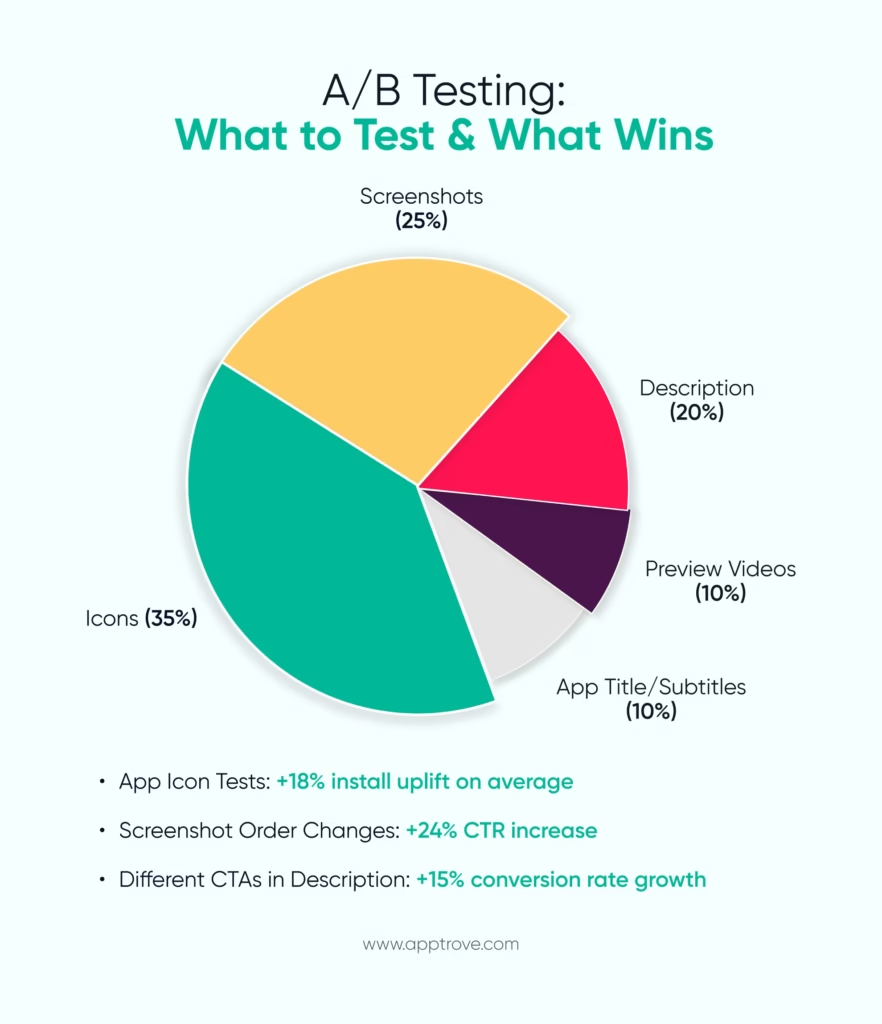
Common Mistakes in ASO (And How to Avoid Them)
While App Store Optimization (ASO) focuses on visibility and downloads, many developers and marketers are still suffering consequences from common traps. A lack of precision, testing, marketed value over utility, user optimization, and performance can negatively impact your ASO app performance. A comprehensive ASO App Store Optimization strategy is more than adding keywords; it involves precision, testing, and user focused optimization.
Misuse of keywords and poor targeting
One of the most common and damaging mistakes made, regardless of performing ASO optimization, is using keywords incorrectly.
- More keywords are better (keyword stuffing): Using a keyword over and over, like “App Store Optimization” or “aso seo” is useless. It can hurt your app’s ranking and make your listing look cheap. In terms of algorithms, you are better to use natural language and contextual for inserting keywords.
- Target by volume and relevant keywords: Going after bigger volume keywords with much less relevance to the app you are building could bring you traffic, but won’t convert. For example, if your asa app is productivity related, if you optimized for a keyword like “mobile games”, you would not get the users you want!
- Solution: Find good anticipated, relevant keywords that have enough volume through an App Store Optimization Tool with a high level of competition but relatively low volume. Align around intent, then consistently change and optimize based on performance analytics.
Disregarding Visuals or User Reviews
Not even the best keywords can help an app with outdated visuals or unmanaged user comments.
- Disregarding visuals: Your app icon, screens, and preview videos are so important to conversion; apps with outdated or too basic visuals are likely to skip over—even if they rank well enough. Good App Store Optimization (ASO) includes A/B testing your visuals to optimize what your audience engages with.
- Disregarding user reviews: User reviews and ratings are direct reflections of the quality of your app. Disregarding them deprives you of that feedback and allows user sentiment (good and bad), to remain addressed.
- Real-world experiences: Many apps have lost ground in ranking after failing to respond to a wave of negative reviews or using stock visuals that did not connect with their audience; apps that improved their visuals and actively managed user feedback often improved their ASO SEO, and had improved user trust, and retention.
Overseeing your app store optimization is a comprehensive project and if you are ignoring or not managing any one of the three essential aspects, i.e., keywords, visuals, or user sentiment, you are likely undermining your app’s growth opportunity with app store optimization effort. By avoiding these common mistakes and using the right App Store Optimization tools, your app store optimization can consistently improve your rankings, downloads, and user satisfaction.
ASO SEO: Blending ASO with Search Engine Optimization
in the digital world we live in today, ASO- App Store Optimization doesn’t happen in a bubble. If you integrate ASO with traditional Search Engine Optimization (SEO), you can create an overall strategy called App Store Optimization SEO which can help further drive traffic to your app listing as it combines not only ASO but search traffic from all angles. You can build discoverability, gain credibility, and drive more downloads for your ASO app from many traffic sources.
How SEO Principles Help ASO?
Using SEO best practices gives your app an upper hand in both stores and digital media when it comes to ASO App Store Optimization.
- Keywords and Metadata: ASO depends heavily on keyword, just like SEO. This means that using industry leading terms in your app name, providing enticing app descriptions, and matching promotional text to keywords- “App Store Optimization Tool,” “aso optimization,” or “aso seo,” or others, are all components of your ASO strategy in the app stores and also Google.
- App page backlinks: Being referred or linked to from trusted written sources through news articles, social media, or blogs can improve your app ranking in search engine results. This will also refer traffic directly to your app store listing.
- Mobile-first indexing + ASO: With Google’s mobile-first indexing and preference for mobile-friendly content and resources, it’s more important than ever to ensure that your online presence (landing page, support site) is mobile friendly. A mobile-first site plus a ASO optimized app listing will help to improve your complete app presence visibility.
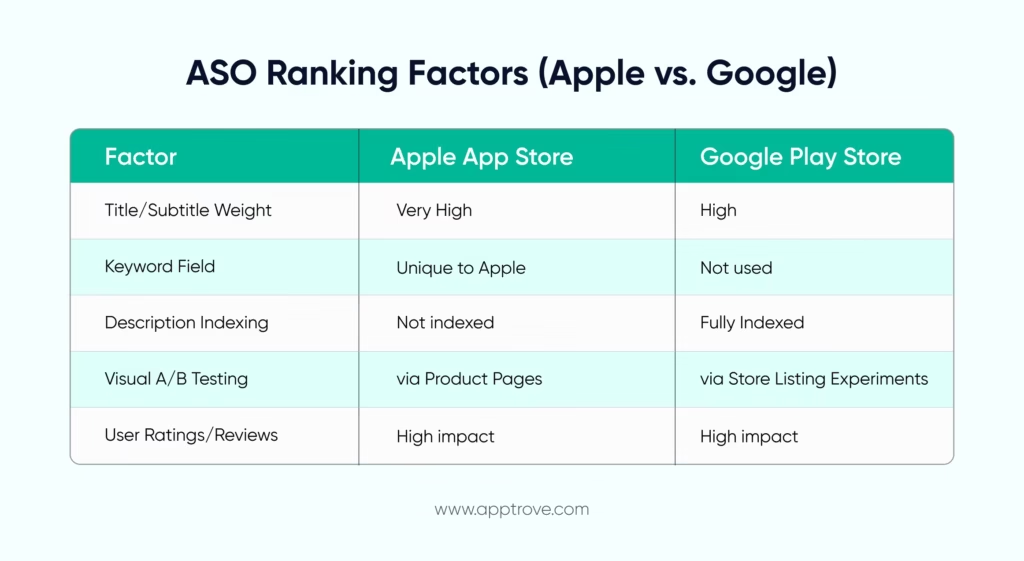
Website / App Store Connection
Building a bridge from your website to your app store presence offers a powerful feedback loop, and as a result improving both SEO and ASO.
- Take Advantage of Websites, Blogs, and Youtube: Creating keyword optimized blog posts and landing pages about your app long-tail keywords and related use cases. Creating Youtube tutorial or explainer videos using words like “App Store Optimization” and “ASO App Store Optimization”. Lastly do not forget to link your app store page directly into every piece of content you create.
- Social Proof & Traffic Flow: Post user reviews, case studies, and testimonials on your website and on your social media platforms. Create an intuitive traffic flow from trust based traffic utilized by social proof to your ASO app listing to create momentum for app downloads and engagement metrics to increase app store rankings.
- Naked SEO Data for ASO Direction: Use your organic keywords trends data from Google Search Console, or SEMrush to focus are analytics based insights from that data to sharpen your App Store Optimization Tool strategies.
By implementing ASO optimization and SEO tactics, your app is now a discoverable, trusted brand—not just an app store listing. This is results in stronger rankings, and higher traffic and downloads from across the web.
The Future of App Store Optimization in 2025 and Beyond
With mobile usage continuing to grow, App Store Optimization (ASO) is changing at a rapid pace. From 2025 and beyond, ASO is becoming more data-driven, automated, and integrated with overall digital marketing approaches. For developers and marketers whose focus is on optimizing their aso app, staying ahead of these changes is critical to their success. An effective ASO App Store Optimization strategy will not only be an advantage — it will be a necessity.
Trends influencing ASO in 2025
The future of ASO optimization is driven by technology, personalization, and user behavior.
- AI in keyword recommendation: Artificial intelligence is changing how keywords are identified and prioritized. Today’s App Store Optimization tools provide AI recommendations to highlight keyword opportunity that would be hidden without human research. To targeting keywords for the above terms, such as “aso seo”, “App Store Optimization Tool.” or highly specific long-tail phrases are slightly better (as any recommendation generated by computers will be far superior).
- Personalization and behavioral targeting: ASO is becoming personalized. App stores are now increasingly taking into account user preferences, devices used and behavioral history when providing search results. To be able to keep pace, aso appdevelopers must adopt a strategy that puts listing content, images, and updates in to alignment with user intent and behaviors.
How To Stay Ahead Of The Game?
With the rapid emergence of new App Store Optimization trends, staying relevant requires responsiveness and knowledge.
- Constant learning and evolving: ASO is not a one-off event. Stay up to date on keyword trends, A/B test your visuals, and optimize your descriptions according to user behavior and platform on the app stores. Use insights from your App Store Optimization Tool to influence your ongoing updates.
- Stay aware of platform updates: With both Apple and Google frequently updating on how they rank apps, stay tuned to stay informed on anything that impacts the way your app is displayed in search and featured positions in the app stores.
- Keep abreast of ASO communities: By being involved in ASO forums, Slack groups, or LinkedIn communities, you’ll have the opportunity to swap suggestions, share results, and keep up to date with all things ASO App Store Optimization.
- Stay on the side of data: Using your analytics and ASO tools, track your metrics for impressions, CTR, Conversion Rate, and User Retention. Use this data as a means to inform your next optimization decision, whether that’s changes to keywords, updating visuals, or some other action.
With App Store Optimization trends evolving so quickly, staying relevant means staying agile and informed.
Conclusion & Action Plan
In today’s app marketplace, being able to stand out today is more than just having a great product; you need to leverage an effective App Store Optimization (ASO) strategy. Regardless of whether you’re launching an entirely new aso app or trying to figure out how you can improve an existing app, an always-on data-driven ASO App Store Optimization strategy will help maximize your app visibility, downloads, and long-term experience for users.
Key Takeaways
Keyword strategy matters: Smart usage of primary and secondary keywords, including “App Store Optimization”, “aso seo”, and “App Store Optimization Tool”, can significantly boost your discoverability.
- Visuals matter: While you may not think much of your icons, screenshots, and promo videos…it is often the tipping point between install or just scrolling past your app.
- User reviews and ratings matter: They matter because of rankings and can build social proof especially if they read it’s a good app. Effectively managing reviews is a large part of your people’s effective aso optimizations.
- An ASO Tool matters: Use a great App Store Optimization Tool to find insights, track competitors, and even test improvements!
Be on top of new updates and trends: Trends including AI, personalization, and localization are going to change the App Store Optimization landscape as we know it… Get in ahead of the curve!
Basic ASO Checklist
Here is a quick-access checklist you can use to implement everything we discussed above:
- Research and prioritize ASO keywords
- Optimize your app title and subtitle
- Write a compelling description full of keywords
- Use high-quality icons, screenshots, and videos
- Localize your ASO content in the top markets
- Solicit and converse with user reviews
- Test your visual and metadata over and over with A/B testing
- Monitor the CTR, conversion, and install rate
- Benchmark competitors using your ASO tools
- Monitor the trends and algorithms
- Encourage Regular Updating and Monitoring
ASO is not a single task—you will want to keep it as a cycle. The app store algorithms change, user behaviors will change, and competition evolves. Revisiting and consistently adjusting your ASO App Store Optimization guidelines will ensure your aso app remains competitive and discoverable.
Evaluate your results, observe your end-users, and never stop experimenting. The apps that will be best prepared in the app stores in 2025 are the ones that decide to use App Store Optimization as a long-term growth engine and not as a one-time process and forget.

